
With Exercise Pitch Black 18 currently in full swing in the skies above the Northern Territory, today’s Throwback Thursday feature from a previous issue of Australian Aviation revisits our look at Pitch Black 12.
‘Train as you fight’ may be a well-worn catch-cry, but it’s an adage that neatly encapsulates the central principle of the biennial Pitch Black.
A three week multinational, multilateral air training exercise, this RAAF-hosted multi-tiered war game presents its participants with the ultimate ‘classroom’ – 320 square kilometres of virtually unrestricted airspace with ready access to over a million hectares of weapons ranges.
Australian Aviation visited RAAF Darwin and was flown to RAAF Tindal to witness a day of simulated combat.
PB12
Pitch Black 2012 (PB12) was staged from July 27 to August 13 and saw six nations take part, sending over 90 aircraft and almost 2,200 personnel.
Aircraft based in Darwin comprised the Blue Force, while those based at RAAF Base Tindal made up Red Force, both representing opposing, hypothetical force elements.
The aim is to test aircrew by pitting them against a simulated but credible adversary to test a variety of skills and missions such as offensive counter air, AEW&C, strike, close air support, tactical airlift and ISR. This is accomplished during the day’s two ‘pushes’, one morning and one evening, during which upwards of 40 aircraft take to the sky from both Darwin and Tindal.
The goal is for each country involved to practice offensive and defensive air tactics within a simulated operational environment, replicated to represent, as closely as possible, today’s network-centric battlespace.
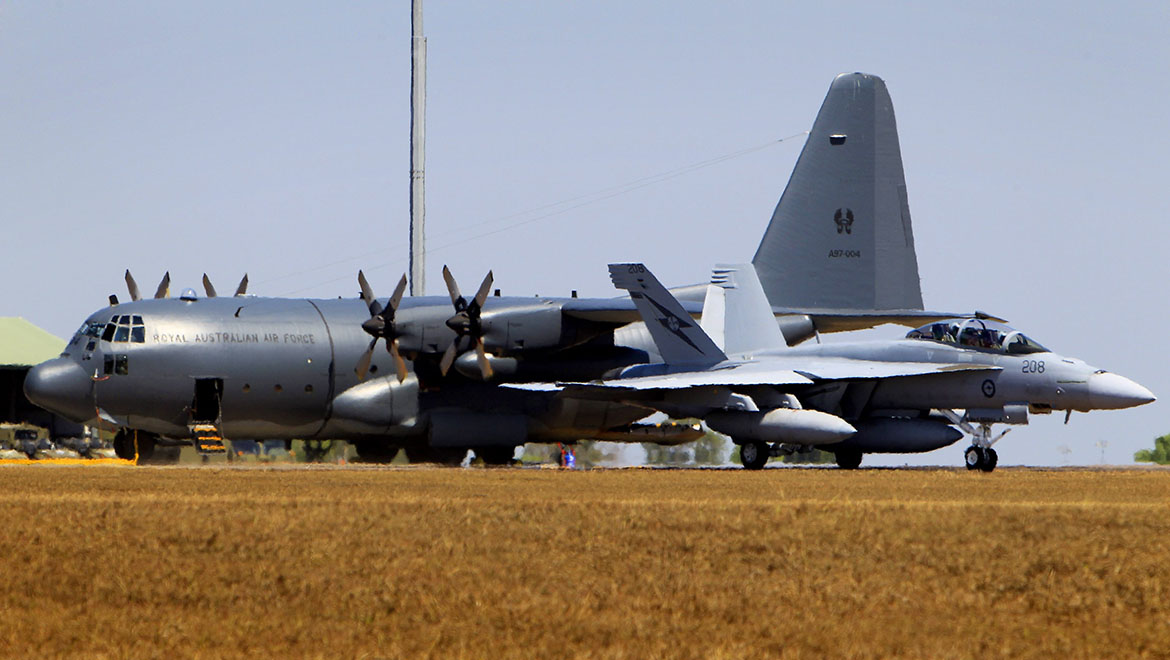
PARTICPANTS
The RAAF as always was this year’s most numerically preponderant participant, with classic Hornets from 2OCU, 77SQN and 3SQN, 1SQN F/A-18Fs, C-130H and Js from 37SQN, King Airs from 38SQN, and a 92 Wing AP-3C occupying ramp space in Darwin, while 76SQN Hawk 127s, 2SQN Wedgetail and 75SQN classic Hornets operated from Tindal. In attendance also were JTACs and combat controllers from RAAF Williamtown-based 4SQN, and ACOs from the No 114 Mobile Control and Reporting Unit (114MCRU), operating its TPS-77 radar at Timber Creek, 285km west of Katherine.
PB12 also saw the debut of 33SQN’s KC-30, which flew a limited number of air-to-air refuelling missions over the NT after transiting from RAAF Townsville.

Assets committed by the Republic of Singapore Air Force (RSAF) comprised 149SQN F-15SGs, 140SQN Block 52 F-16Ds, 143SQN Block 52 F-16Cs, 112SQN KC-135R and the star of the RSAF detachment to Darwin, the Gulfstream 550 AEW platform, operated by 111SQN. All RSAF aircraft were based in Darwin, and for the Gulfstream and the Eagle, it was also a Pitch Black debut.

The Royal Thai Air Force’s 403SQN sent its Block 15 F-16s and 102SQN RTAF sent its Block 15 F-16A ADFs equipped with Altis II targeting pod and the Rubis navigation pod. These were based in Darwin for the duration.

The RNZAF was represented, sending not aircraft but combat support personnel to participate. US participation came from the US Marine Corps with F/A-18Cs and KC-130Js.
And as though the list of first-time participants in Pitch Black couldn’t get any more impressive, it was Indonesia’s TNI-AU’s 11th Air Squadron Su-27s and Su‑30s that stole the show and provided the exercise’s greatest talking point. Four Sukhois were based at Darwin for a fortnight before returning home to their base at Saltan Hassanuddin AB in South Sulawesi.
The deployment signals a growing determination by Indonesia to engage regionally, and marks a significant deepenng in Indo/Australian relations following Chief of Air Force AM Geoff Brown’s March visit to Indonesia. With a reoriented US military posture in the region and warmer relations with Australia, participation in exercises like Pitch Black are hopefully to be a more common occurrence.
Pitch Black Exercise director and ACG Chief of Staff GPCAPT Mike Kitcher explains that in order to maximise the value of the exercise roles are shared between participating nations.
“No one country flies OCA or strike or CAS or escort. Everyone is tasked for different missions every day – that’s the beauty of Pitch Black. You can be doing strike, CAS one day and escorting a C-130 the next, pre-strike sweep another day and so on. We deliberately mix that up and mix the packages up to allow the various countries to work together – as opposed to having, for example, Australian aircraft on one side of the airspace and Singaporean or Thai aircraft on the other.”
While the broad aim of the exercise is to foster greater regional engagement and enhance interoperability, PB12’s practical purpose is to construct a realistic and credible combat scenario using as many fast jets and combat force multipliers as possible, involving fixed wing aircraft and air/land integration.
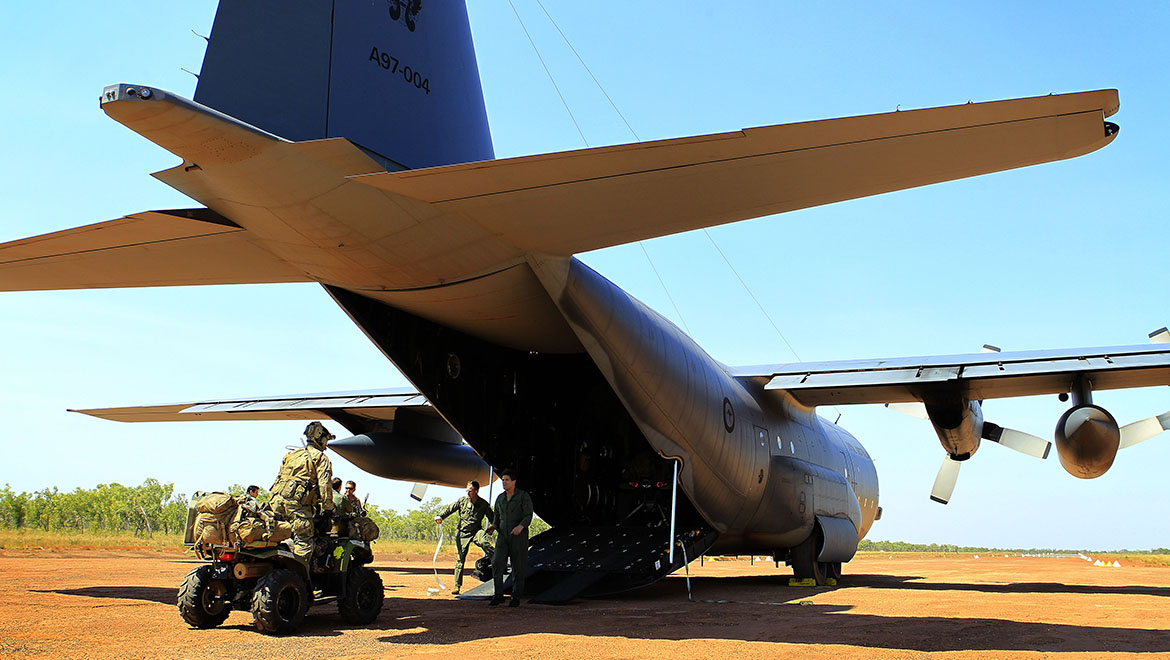
GPCAPT Kitcher explained both the scope of platforms and capabilities that go into creating a large-scale exercise like Pitch Black.
“We’re conducting OCA and strike missions but mixed with those we’ve got a lot of high value escort missions for the Herc. I’ve got air-to-air refuelling and Wedgetail and the Gulfstream 550 providing a surveillance picture for the entire push. In addition, we’ve got a TPS-77 radar at Timber Creek, which is also being used to construct the air picture and we’ve got controllers in the back of the Gulfstream and Wedgetail as well as controllers down at RAAF Williamtown in the Eastern Regional Operations Centre.
“The tactical aim is to operate in an OCA environment, to conduct large force, counter-air missions against a credible adversary. They also involve some EW simulation down in Delamere Air Weapons Range and within that we’re also conducting CAS or offensive air support missions. Lastly, we’re involving C-130s to insert and extract 4SQN combat controller teams and we’ve also been using the Beech 350 and P-3 to conduct some ISR missions.”
What makes this particular Pitch Black stand out for GPCAPT Kitcher is the unprecedented level of information sharing between participating multinational aircraft, thanks to Link 16 JTIDS.
“The Wedgetail and the Gulfstream, with both those assets, plus the TPS-77, for the first time for a Pitch Black it gives us a quality Link 16 picture for most participants, so we’ve got a common picture, a Blue pic and a Red pic. We’re also using Link 16 messaging in various taskings and retaskings of airborne assets as well, so it’s significant.”
ANATOMY OF A MISSION
Mock combat involving large force elements (LFE) demands careful cooordination to both maximise training output and avoid deconfliction. 75SQN CO WGCDR Phil Arms describes the planning of a typical Pitch Black sortie.
“We have assigned mission commanders in Red and Blue force. Every VUL (or verability period, the allocated time when the fight is on) that goes ahead – either morning or night – you’ll have a Red and Blue mission commander and it’s their job to come up with a game plan. It’s their job to get all the assets listed, choose the target sets they’re going against, decide what weapons to use, what considerations for employing those weapons and also to decide how they’ll protect high value assets they’ve got. Then they must work out how they’ll build a strike package (from a Blue perspective), how they’ll provide an escort and a sweep and how they’ll tie it all together.
“On the Red side, the Red mission commander is to get all the assets to fight the opposition and then work out how to simulate a defensive posture. Specifically for the Red, our postures are tailored for learning objectives, so if we know that there’s a vulnerability in azimuth or a particular part of their game plan then we make sure we design a Red posture that will challenge that and exploit it.”
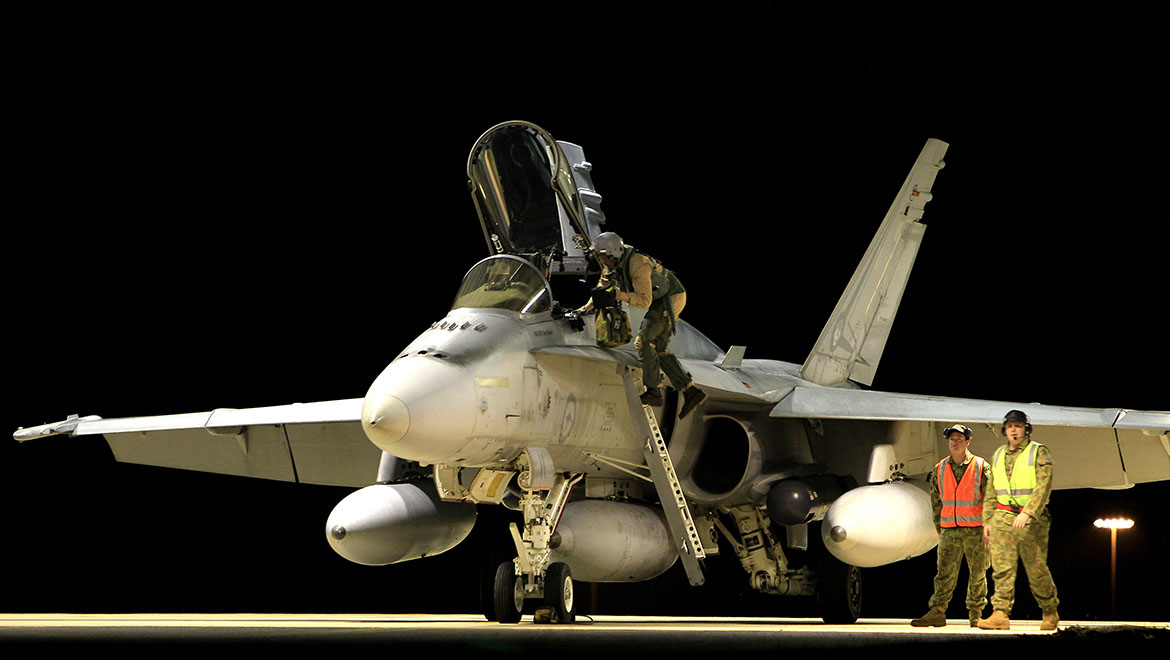
BROAD OPEN SKIES
GPCAPT Kitcher has participated in many other large advanced aerial training exercises such as Red Flag, and points to the one decided advantage Pitch Black enjoys over similar war games.
“Red Flag Nellis is probably the premier air combat exercise, and it’s certainly well supported with undulating terrain and a significant sweep of ground-based air defence emitters. However, it’s also held in relatively small airspace – it would probably fit four or five times in the PB airspace. Rarely do you get the freedom of manoeuvre that you have in the Territory. You have an airspace that’s 200 miles square and zero to 50,000ft that you can go supersonic in, and doesn’t have any airlines or airways through it. It’s basically just fighting airspace.”
TEMPORARILY AT TINDAL
Three hundred kilometres south of Darwin lies RAAF Base Tindal. Nestled under its maze of hardened aircraft shelters are the Hornets of the base’s resident unit, 75SQN. Tindal’s hardstands also play host to a variety of visitors, from an Omega Air Boeing 707-338C tanker, (ex RAAF 33SQN A20-624), RAN Support Flight Learjet 35A, Marine Corps VMFA-232 F/A-18Cs, two KC-130Js of VMGR-152 and the aforementioned Hawks, AP-3Cs and Wedgetail. The latter is housed in a purpose-built hangar, with the squadron using Tindal as a semi-permanent Forward Operating Location.
WGCDR Arms outlines his unit’s role in the exercise, saying its mission is to launch from Tindal and provide the Darwin-based Blue Force with a simulated, real world threat. Whereas an average day’s flying for his squadron may involve putting up two Hornets for BFM (basic fighter manoeuvring), Pitch Black demands a maximum effort of both aircrew and support personnel as the squadron surges to launch eight aircraft for each of the day’s two waves.
To a squadron commander, the benefit of Pitch Black for aircrew is both immediate and tangible.
“It gives us the opportunity to put our aircrew in a very complex air environment, so you can imagine as the only squadron based out of Tindal, we are challenged to get more than eight to ten aircraft up at one time, whereas a typical sortie here will have 20 aircraft fighting against 40. You can throw guys out there and where they think they understand what’s going, actually their situational awareness is nothing like they perceived and the complexity of the fight and how quickly it occurs is great training for them.”
Unfortunately for the squadron, it did not get to tangle with the Indonesian Flankers based out of Darwin.
“We did manage to go up against the Singaporeans, they gave us a real challenge in the beyond-visual range arena, but as soon as we get into the visual arena, the playing field is very, very even. In fact our guys did very well.”

Lucky enough to mix it with the Soviet era superfighter was 1SQN, which brought its Super Hornets to Darwin for the first of no doubt many Pitch Black exercises. 1SQN’s commanding officer, WGCDR Murray Jones, told Australian Aviation that the F/A-18F performed creditably against the Flanker.
“We did quite well. You’ve got to be careful the lessons you take away from those [engagements]. It’s all about setting defined lessons for yourself and the other force. Often those missions aren’t always a pure test or evaluation of the full-up capability of the aircraft – we often structure the mission to get specific lessons so it’s very difficult to actually make those assessments of which aircraft is better. That said, we’re pretty comfortable about the capability of our aircraft.”
As GPCAPT Kitcher explained, the approach taken towards the Indonesians on their first Pitch Black was to be more a familiarisation than a baptism of simulated fire.
“We went softly, softly. This is the first time they’ve deployed their Su-27 and Su-30 out of Indonesia and it’s their first involvement in an exercise of this scale with the Sukhoi as well. We involved them in some 1 v 1, 2 v 2 and some 4 v 4 missions, during the force integration training and we involved them in the LFB that we flew last Thursday where they escorted a couple of classic Hornets down to a target.
“They were part of the missions and large OCA mission that we ran but had to do that in a very careful manner.”

No such deference was shown the RAAF’s Super Hornets, however, with the aircraft’s full spectrum of multirole capabilities tested to the limit by the exercise. WGCDR Jones outlined the type of tasks undertaken by 1SQN at Pitch Black 2012.
“For OCA, we’d sweep ahead of the strike package and clean out the Red Air and defend the target area, which allowed the strike package in to hit the targets and then we escort them out again. We also did strike ourselves, with other aircraft from other countries. In that scenario, the classic Hornets provided the OCA and sweep for us, allowing us to get in, strike our targets, and get out.”
With JHMCS, datalink and AESA radar, the Super Hornet and the Singaporean F-15SG presented mission planners with equivalent capabilities when it came to determining the composition of the exercise’s Large Force Elements.
“It might just be a different brand of targeting pod – one might have some strengths and weakness over the other one, but when it comes to achieving the missions [the two aircraft] are effectively interchangeable.”
PB12 is a vital step in the Super Hornet’s work up to FOC, expected to be declared by 82 Wing in December this year. While on exercise, the squadron used Pitch Black to put Super Hornet aircrew through categorisation skill progression, which can see a junior pilot begin the exercise as a wingman and finish it as a deputy flight leader. A cadre of experienced aircrew is necessary if, as is expected, the squadron is declared fully operational by year’s end.
HARD CORPS
The Marine Corps’ VMFA-232 ‘Red Devils’, part of MAG 12 and normally based at MCAS Miramar (of Top Gun fame) near San Diego, California was accompanied by two Okinawa-based USMC KC‑130Js to provide air-to-air refuelling support which, like the Hornets, arrived in Darwin in early August to take part in the joint ADF/USMC exercise, Southern Frontier.
VMFA-232’s operations officer Major Dustin J Byrum said it was the first time his highly decorated unit had participated in a Pitch Black and that the exercise represented an invaluable training opportunity for the unit’s 290 personnel. Of particular value was Tindal’s close proximity to the Delamere range.
“We’ve been able to do a lot of CAS, some Marines from Fox 23, the guys from [Rorbertson Barracks] Darwin and some from Okinawa, they were on the ground in Delamere. Also, we did CAS with the SAS and that was really good. Our bread and butter is close air support, so it’s definitely our most important mission.”

Planning for a typical sortie took the squadron around ten hours and comprised teleconferencing with exercise planners in Darwin and the inevitable powerpoint presentation to aircrew on the morning of a push. Maj Byrum described the relationship with hosts and fellow Hornet drivers 75SQN as excellent, and expressed a similar disappointment that the Red Devils’ F/A-18Cs were unable to mix it with the Indonesian Flankers.
Nontheless, explains Maj Byrum, “It’s been a great exercise. It’s all about readiness – for some of our guys it’s the first time they’ve been out in large 40 v 40 large force elements, so for us, that’s invaluable.”
EYE IN THE SKY
Williamtown-based 2SQN sent two aircraft to participate in this year’s Pitch Black, along with roughly 60 personnel.
The squadron now maintains a forward operating location at Tindal, enabling temporary but supported deployments of this important air asset to the Top End.
A key force enabler, the Wedgetail is rightly classed by exercise planners as a high value asset, being used to form an overall picture of the battlespace. The Wedgetail utilises its MESA radar and Link 16 to provide critical command and control (C2) for strike packages and large force elements to better shape their situational awareness during the fight.
As is now common in network-centric warfare, the Wedgetail finds itself as a hub in a greater, networked battlespace, in which it receives, collects and conveys information to other friendly platforms.
As with the Super Hornet, the E-7A Wedgetail used Pitch Black as an important opportunity to test its ability to integrate with other C2 agencies as it progresses towards FOC.

2SQN XO SQNLDR Simon Wildermuth points out the benefits of PB12: “The best thing about Pitch Black is the integration with airborne C2 and ground-based C2. One C2 agency will be the primary for the Blue push and another – Singapore or ourselves – will be the backup C2 agency and then another will hold the Red side while it undertakes OCA, DCA, strike and force marshalling and we’ve been rotating through those roles throughout the exercise. The integration comes from the distribution of the picture and the coordination of the C2 agencies, using the tactical datalinks to distribute the picture and getting that validated, ID’d and out to everyone else is the main thing that we’ve had.”
ENTER THE KC-30A
Another important platform making its inaugural appearance at Pitch Black was 33SQN’s KC-30A.
Staging out of RAAF Townsville, the multi-role tanker conducted scores of hose and drogue refuellings over the exercise with classic Hornets. Not surprisingly, there is genuine enthusiasm about the RAAF’s acquisition of an organic AAR capability, especially from the fast jet fraternity.
75SQN’s WGCDR Arms explains what the KC-30 means to the Hornet community: “It means gas. And a lot of it. It’s been awesome to have it in this exercise, overhead Tindal almost every day. It carries more fuel than I can put in this base. And the fact that it’s flying is a massive force generation. We’ll put four jets on there, fill up to the brim, and put another eight and another eight, and it’s just got more fuel to give. It’s an incredible force enabler.”
But it’s not just the fighter community who welcome the KC-30A’s arrival. The Wedgetail, equipped with its boom enabled air-to-air refuelling receptacle, will be able to extend its already-impressive ten-hour endurance thanks to 33SQN’s multi-role tanker. All going well, the Wedgetail should be conducting refuelling sorties from the KC-30 at the next Pitch Black exercise in 2014.
SQNLDR Wildermuth explains what that capability will mean to the prosecution of 2SQN’s mission: “It means persistence. Being able to be on station for a longer time reduces the number of aircraft we need to fly in there and number of handovers between C2 agencies. It also increases our ability to go to places in a much more rapid sense.”
H MODEL FINALE
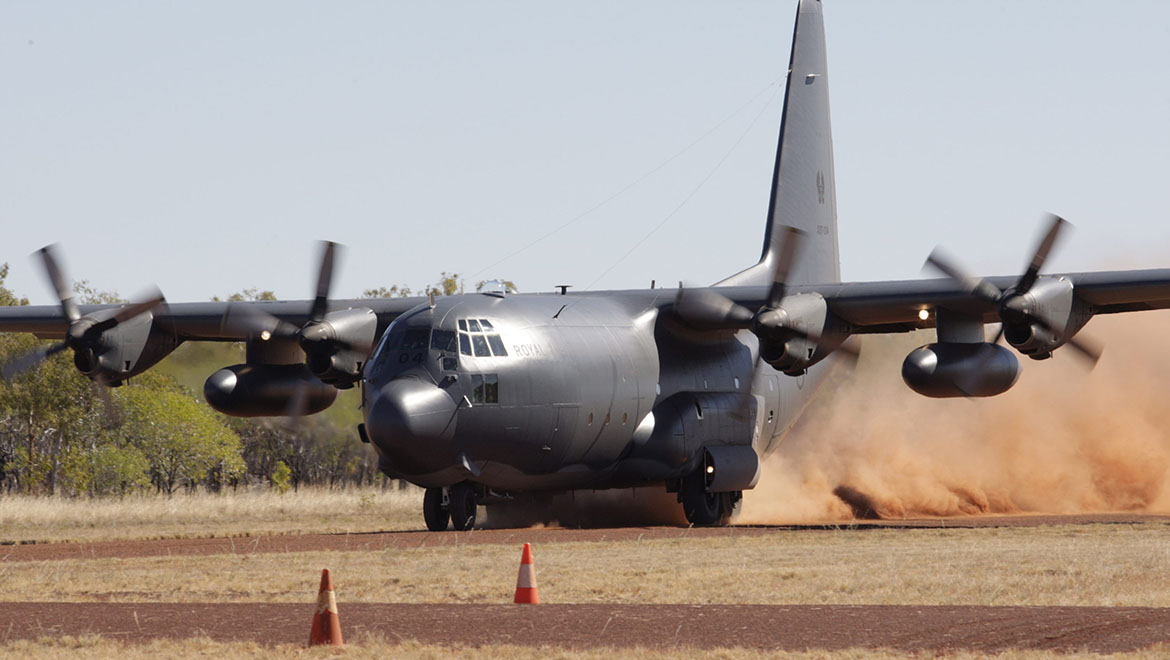
While types such as the Wedgetail, KC-30 and Super Hornet are receiving their Pitch Black initiations, the C-130H of 37SQN bidded its adieu to the exercise before it retires in December. A number of the H model Hercules fleet are to be transferred to the TNI-AU for use in regional disaster relief, a move announced during the Indonesian President’s trip to Darwin in July. The visit was also used to sign a Memorandum of Understanding between Australia and Indonesia aimed at boosting regional cooperation between the two nations.
And with the presence of the TNI-AU Flankers at Pitch Black, it can be seen that is an agreement yielding tangible results.
VIDEO – Pitch Black 2012 was a milestone exercise for many reasons, as then GPCAPT Mike Kitcher explains in this RAAF YouTube clip.
PITCH BLACK 2014
As the largest air defence exercise in the Southern Hemisphere, participation in Pitch Black is a very attractive proposition for regional air arms constrained by geographical limitations from conducting their own complex war games. Thus Pitch Black will remain a vital opportunity for regional air forces and the ADF to acquire, maintain and hone vital warfighting skills.
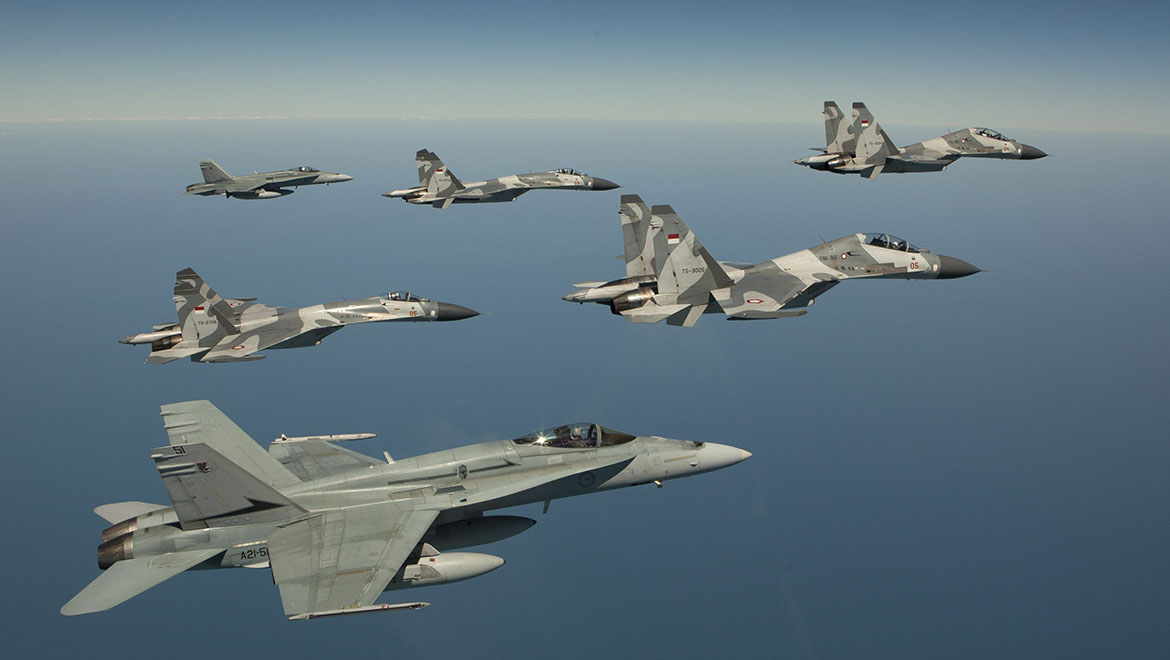
Today’s Throwback Thursday feature article originally appeared in the October 2012 issue of Australian Aviation.
To read more stories like this, subscribe here. Digital editions of the magazine can be purchased on Zinio and Issuu, or in the Apple app store.















David
says:Ironically funny seeing frontline Indonesian military aircraft participating. I thought the whole point of the exercises was to practice defending against Indonesia.
Rich
says:No, that was “Kamaria” .. and don’t mention East Timor or West Papua …